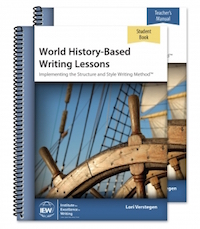
September is nearly over, but before you switch from retelling stories in Unit 3 to funneling facts in Unit 4, check out these story samples pulled from two of our latest theme-based books. People and Places in our Community is a pre-Level A theme-based book that is perfect for children in kindergarten through Grade 2. For older students check out the sample taken from World History-Based Writing Lessons, a Level B resource generally recommended for Grades 6‒8.
For those who have our Premium Membership, this is a wonderful way to test out our IEW online IEW Checklist Generator™. Check out Unit 3 in Teaching Writing: Structure and Style for directions on how to outline and write the story.
Without further ado, here are two models for your writing enjoyment.
People and Places in Our Community
The Emergency Room
One bright, sunny day, Mike and his dad went to the park. He wasted no time in finding adventure. He swung high on the swings. He raced down the slide. He spun on the merry-go-round. His favorite was the monkey bars. He loved the feeling of being up so high. He scrambled to the top. Then, as fast as he could, he swung from bar to bar. First, he went one way. Then he went the other. Faster and faster he traveled across the monkey bars. Suddenly, his hand slipped! He fell to the ground, landing on his arm. Mike’s dad hurried to his side and asked if he was okay. Mike said that his arm hurt so much that he could not move it.
Mike’s dad knew just what to do. They drove to the emergency room. When they got there, the doctor felt Mike’s arm and sent him in a wheelchair to get an x-ray. The x-ray showed that Mike’s arm was broken. He was going to need a cast. The nurse wrapped Mike’s arm in a bandage with a sticky gauze that turned hard when it dried. Mike’s arm felt much better in the cast. One the way home, Mike’s dad asked if he thought he would enjoy some ice cream! Mike agreed this would be a very good way to end an eventful day.
World History-Based Writing Lessons
Isaac Newton
Isaac Newton was a student at Cambridge University when the black death, also called the Great Plague, struck nearby London again. It was a horrible disease that the people did not know how to cure. Thousands died. Misery, despair, and fear were everywhere. Soon fear turned to panic. Riots broke out in the streets. London was locked down, and Cambridge was closed. Isaac retreated to his mother’s home in the countryside. Isaac Newton had many questions about the universe. He did not let the closing of the school close his mind. He used the time to experiment and think. One day he went into his mother’s garden. It was a beautiful sunny day, but he hardly noticed. He was sitting in the shade of an apple tree, deep in thought. As he sat there, an apple fell from the tree. It plummeted straight down.
That caused him to ask questions. Why did the apple fall straight down? Why did it fall at all? Why did it not float in the air or fall up? And why do all things fall to the ground when not supported? Why does everything seem stuck to the earth? To answer his questions, Newton developed a new kind of math. He labored over many equations. He eventually figured out that all objects attract other objects. He reasoned that since the earth is so large, its force must be very strong. So, when the apple broke from the branch, it was pulled toward the center of the earth by this force. He believed that this was the same force that kept the moon from flying away from the earth. He wrote about it in a book called Principia. He called his idea the Law of Universal Gravitation. Isaac Newton discovered much about gravity!
Epilogue
The story of the falling apple is likely true, though the apple probably did not fall on his head as some stories say. The incident is included in Stukeley’s biography of Isaac Newton, Memories of Sir Isaac Newton’s Life.
Bibliography
Nix, Elizabeth. “Did an apple really fall on Isaac Newton’s head?” History.com,
13 Nov. 2015, http://www.history.com/news/ask-history/did-an-apple-really-fall-on-isaac-newtons-head
We hope you enjoyed these new product samples. If you have any questions about them, please feel free to contact us. We are always very happy to help!
IEW Checklist Generator is a trademark of the Institute for Excellence in Writing, L.L.C.


